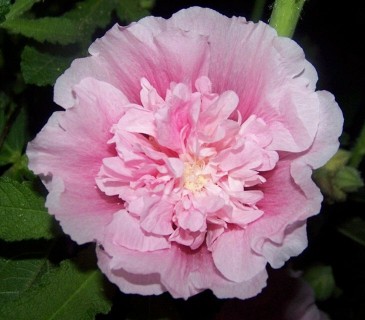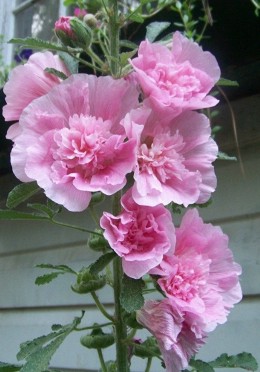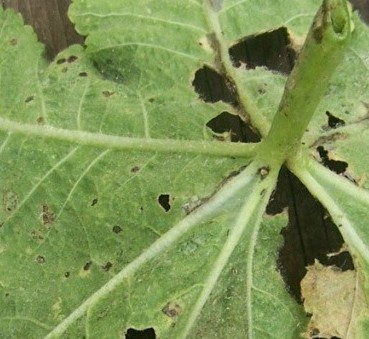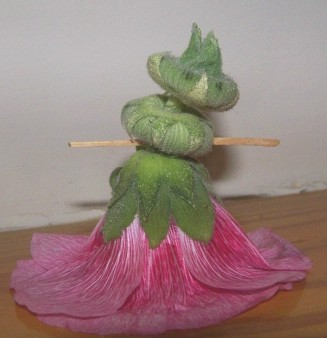|
Detailed
Biennial
Profiles
Biennial Herbs
Black-Eyed Susan
Canterbury Bells
Dame's Rocket
Evening Primrose
Foxglove
Salvia
Sweet William
Wallflower
Site Map
Home
Annuals
Architectural Elements
Backyard Habitat
Biennials
Bonsai
Bulbs
Cactus/Xeriscaping
Companions
Composting
Container
Gardening
Crafts
Gardening Q/A
Garden
Ornamentation
Gargoyles
Greenhouses
Ground Covers
Herbs
Houseplants
Insects/Diseases
Landscaping
Organics
Perennials
Ponds
Propagation
Recipes
Roses
Seeds
Shade Gardens
Shrubs/Hedges
Tools
Trees
Vegetables
Vines
Weeds
Wildflowers
Wildlife
Shop Gardening


 |
 Whether
you are a casual weekend gardener or cultivate an elaborate cottage garden or
English garden, there's likely a place in your landscape for the old-fashioned
favorite, Hollyhock. Easy to grow from seed, Hollyhocks (Alcea rosea
"Summer Carnival" pictured here) have been favorites of gardeners for hundreds
of years due to their large size, showy flowers, and easy cultivation.
Growing quickly (after a waiting period) up to 12 feet and even higher, Hollyhocks make good back of
border plants, screening plants, or even focal points in the landscape. Whether
you are a casual weekend gardener or cultivate an elaborate cottage garden or
English garden, there's likely a place in your landscape for the old-fashioned
favorite, Hollyhock. Easy to grow from seed, Hollyhocks (Alcea rosea
"Summer Carnival" pictured here) have been favorites of gardeners for hundreds
of years due to their large size, showy flowers, and easy cultivation.
Growing quickly (after a waiting period) up to 12 feet and even higher, Hollyhocks make good back of
border plants, screening plants, or even focal points in the landscape.
 Hollyhocks
are closely related to Hibiscus,
Rose of Sharon, and okra, other well-known
members of the Mallow family, all of which grow to good-sized plant specimens
with similar flowering habits. As Biennials or short-lived Perennials,
they will not flower in the same year the seeds are planted, but rather will
form a rosette of leaves in the first year, and then zoom upward and flower
surprisingly quickly in late spring or early summer of the next year. Use
anywhere that a background, screen, or tall accent plant is needed.
Highlight a front door or garden entryway for impressive impact, or to soften
the line of a fence. Use as a screen or divider to hide a neighbor's yard,
telephone pole, or utility area, or plant in front of a deck to screen the
barren area underneath. Plants reseed themselves readily, and as such,
once the first year is over, there should be a continuous supply of
ready-to-bloom plants in any particular year once the plants are started in an
area. Hollyhocks
are closely related to Hibiscus,
Rose of Sharon, and okra, other well-known
members of the Mallow family, all of which grow to good-sized plant specimens
with similar flowering habits. As Biennials or short-lived Perennials,
they will not flower in the same year the seeds are planted, but rather will
form a rosette of leaves in the first year, and then zoom upward and flower
surprisingly quickly in late spring or early summer of the next year. Use
anywhere that a background, screen, or tall accent plant is needed.
Highlight a front door or garden entryway for impressive impact, or to soften
the line of a fence. Use as a screen or divider to hide a neighbor's yard,
telephone pole, or utility area, or plant in front of a deck to screen the
barren area underneath. Plants reseed themselves readily, and as such,
once the first year is over, there should be a continuous supply of
ready-to-bloom plants in any particular year once the plants are started in an
area.
Red is the most common color for Hollyhocks,
but many more colors are readily available to the average gardener today,
including yellow, purple, white, and pink variations, as well as near black. The
single or double flowers
spring forth from large buds attached to short stems, which in turn are attached
to the main stem. The buds alternate all the way up the thick and somewhat hairy
main stem to the very top, which can be way up there (the one pictured is about
10 feet and still going up). Strong side stems also emerge, also covered with
buds for a long-lasting show indeed (see full-plant picture below). Each bloom lasts for a few days, and the entire blooming period is
maybe 6 weeks or better. Stems are straight and strong, and don't usually require
staking in normal weather, but have been known to topple in heavy rain or
storms.
 As far as problems with
diseases and insects, Hollyhock unfortunately has its share, and in fact is
famous for Hollyhock Rust. Basically, if you grow Hollyhocks, you will
have Hollyhock rust to some degree. Hollyhock Rust is a fungus that is
spread by insufficient air circulation, overhead watering, and rain. It
looks like red or orange bumps on the undersides of the leaves early on, and
then advances, destroying leaf tissue as it goes. The more wet and humid
it is, the worse the problem will be. Some gardeners refuse to grow
Hollyhock because of Hollyhock Rust, but look again at the pictures above and
you might rethink that. Yes, the rust is ugly but it probably won't kill
the plant unless the plant is already stressed by underwatering or disease.
Good gardening practices can keep it somewhat in check, so if you want to grow
Hollyhock, make sure you mulch heavily to keep soil from splashing on the
leaves, water from below when possible, and As far as problems with
diseases and insects, Hollyhock unfortunately has its share, and in fact is
famous for Hollyhock Rust. Basically, if you grow Hollyhocks, you will
have Hollyhock rust to some degree. Hollyhock Rust is a fungus that is
spread by insufficient air circulation, overhead watering, and rain. It
looks like red or orange bumps on the undersides of the leaves early on, and
then advances, destroying leaf tissue as it goes. The more wet and humid
it is, the worse the problem will be. Some gardeners refuse to grow
Hollyhock because of Hollyhock Rust, but look again at the pictures above and
you might rethink that. Yes, the rust is ugly but it probably won't kill
the plant unless the plant is already stressed by underwatering or disease.
Good gardening practices can keep it somewhat in check, so if you want to grow
Hollyhock, make sure you mulch heavily to keep soil from splashing on the
leaves, water from below when possible, and clip the lower leaves regularly. Rust starts from the bottom and works its
way up, so as soon as you see lower leaves starting to decline, clip them with
garden shears and throw them in the trash (not the compost heap lest you infect
other Mallows). No
matter how hard you try, you will never completely control rust on Hollyhocks,
so if you love these plants as much as you should, you will just resign yourself
to taking the good with the bad, and hope that science will breed a Hollyhock
that is immune to rust soon. Slugs, weevils, and caterpillars like this plant too, so by
the end of flowering, you might just find yourself with a skeletonized stem with
flowers on it, but again, sometimes in gardening, you have to take the good with
the bad. Hey, you still have the flowers at least. This year, we have had a drier than normal spring (drought
really), and it hasn't been as humid. My plants are really faring quite
well considering, as you can see in the full-plant picture to the right.
Again, this one is about 10 feet tall and is really pretty gorgeous, with only
minor damage so far to the bottom-most foliage. .
clip the lower leaves regularly. Rust starts from the bottom and works its
way up, so as soon as you see lower leaves starting to decline, clip them with
garden shears and throw them in the trash (not the compost heap lest you infect
other Mallows). No
matter how hard you try, you will never completely control rust on Hollyhocks,
so if you love these plants as much as you should, you will just resign yourself
to taking the good with the bad, and hope that science will breed a Hollyhock
that is immune to rust soon. Slugs, weevils, and caterpillars like this plant too, so by
the end of flowering, you might just find yourself with a skeletonized stem with
flowers on it, but again, sometimes in gardening, you have to take the good with
the bad. Hey, you still have the flowers at least. This year, we have had a drier than normal spring (drought
really), and it hasn't been as humid. My plants are really faring quite
well considering, as you can see in the full-plant picture to the right.
Again, this one is about 10 feet tall and is really pretty gorgeous, with only
minor damage so far to the bottom-most foliage. .
So, if you still want to grow Hollyhock even
knowing the pitfalls, seed is easy to start. Just clear some ground in
full or near full sun and scatter seed, covering only very lightly, as seeds
need some light to germinate. Alternatively, you can start the seed in
flats with potting soil and transplant later with good results. Seed takes
14-21 days to germinate and about 365 days to bloom for most varieties.
Once seedlings are up, thin plants to no closer than about 12-14 inches.
These plants can be deceiving, as when they are in the rosette phase in their
first season, they are quite small, so be careful not to space too closely or
you will aggravate the problems described above. Average garden soil is good
enough for this plant, but a good covering of mulch is a must, both to keep the
ground evenly moist and to eliminate splashing from watering and rain.
Once the plant has finished flowering, you can either cut it to the ground or
let it stand for a while until the seed pods mature and split, dispersing new
seed on the ground. In some climates, the plant may re-form underneath the
cut in the stalk for a new plant next year. Hollyhock will often sprout
where you don't want it next season if you let the seed pods disperse seed where
they want to, but seedlings transplant easily and this shouldn't be a problem
for a halfway well-tended garden.
If you have kids and a little bit of room in
the yard, try building them a Hollyhock House (Sunflowers work well for this
too). Simply plant your Hollyhock seeds in a circle, square, or whatever
shape leaving an opening about 5 feet wide for a door with easy access in and
out, and let the Hollyhocks grow. Kids love to feel that they have a
private space in nature to play or just get away. Some people put stakes
around the inside perimeter and tie string from one side of the door around the
back, and up to the other side of the door to make it seem more like a room, but
this is optional. I wish I had room to do this on my property so I could
take a picture, but alas, I do not.
 If
you have little girls, try making Hollyhock dolls. Just choose a flower
and cut it off, bud and all, then choose two more buds, cutting them off at the
stem. Using toothpicks, attach the skirt (flower), body (one of the buds),
and head (second bud) and then stick a toothpick through the body sideways to
make arms as depicted in the picture. Paint eyes in the appropriate place with a
thin marker and poof, you have a Hollyhock doll. Yeah, I know I could have
centered the arms on mine a little better. Picky, picky, but she's still
kinda cute and she has a dress to die for. Also, if you have single flowers, you
can float these beauties in water, so make a few and watch them dance! If
you have little girls, try making Hollyhock dolls. Just choose a flower
and cut it off, bud and all, then choose two more buds, cutting them off at the
stem. Using toothpicks, attach the skirt (flower), body (one of the buds),
and head (second bud) and then stick a toothpick through the body sideways to
make arms as depicted in the picture. Paint eyes in the appropriate place with a
thin marker and poof, you have a Hollyhock doll. Yeah, I know I could have
centered the arms on mine a little better. Picky, picky, but she's still
kinda cute and she has a dress to die for. Also, if you have single flowers, you
can float these beauties in water, so make a few and watch them dance!
And lastly, if you haven't had enough
Hollyhock for today, this plant is a minor herb too! Good heavens, you can
grow a fort, play dolls with your kid, screen out the ugly neighbors, and self
medicate all with the same plant! Although there is a long history of
Hollyhock usage for various complaints from mouth problems and loose teeth to
gonorrhea, the plant today is used by herbalists mainly for cold and cough
related health issues. The plant indeed contains a substance that appears
to soothe inflamed mucus membranes, and the leaves (or preferably the root)
boiled in water and drunk as a tea is apparently a safe and reasonably effective
remedy for minor cold and cough symptoms. There are no known drug
interactions related to ingesting any of the mallow family plants, including
Hollyhock. For complete herbal tea-making instructions,
click here.
|




|
 Whether
you are a casual weekend gardener or cultivate an elaborate cottage garden or
English garden, there's likely a place in your landscape for the old-fashioned
favorite, Hollyhock. Easy to grow from seed, Hollyhocks (Alcea rosea
"Summer Carnival" pictured here) have been favorites of gardeners for hundreds
of years due to their large size, showy flowers, and easy cultivation.
Growing quickly (after a waiting period) up to 12 feet and even higher, Hollyhocks make good back of
border plants, screening plants, or even focal points in the landscape.
Whether
you are a casual weekend gardener or cultivate an elaborate cottage garden or
English garden, there's likely a place in your landscape for the old-fashioned
favorite, Hollyhock. Easy to grow from seed, Hollyhocks (Alcea rosea
"Summer Carnival" pictured here) have been favorites of gardeners for hundreds
of years due to their large size, showy flowers, and easy cultivation.
Growing quickly (after a waiting period) up to 12 feet and even higher, Hollyhocks make good back of
border plants, screening plants, or even focal points in the landscape.
 Hollyhocks
are closely related to Hibiscus,
Hollyhocks
are closely related to Hibiscus,  As far as problems with
diseases and insects, Hollyhock unfortunately has its share, and in fact is
famous for Hollyhock Rust. Basically, if you grow Hollyhocks, you will
have Hollyhock rust to some degree. Hollyhock Rust is a fungus that is
spread by insufficient air circulation, overhead watering, and rain. It
looks like red or orange bumps on the undersides of the leaves early on, and
then advances, destroying leaf tissue as it goes. The more wet and humid
it is, the worse the problem will be. Some gardeners refuse to grow
Hollyhock because of Hollyhock Rust, but look again at the pictures above and
you might rethink that. Yes, the rust is ugly but it probably won't kill
the plant unless the plant is already stressed by underwatering or disease.
Good gardening practices can keep it somewhat in check, so if you want to grow
Hollyhock, make sure you mulch heavily to keep soil from splashing on the
leaves, water from below when possible, and
As far as problems with
diseases and insects, Hollyhock unfortunately has its share, and in fact is
famous for Hollyhock Rust. Basically, if you grow Hollyhocks, you will
have Hollyhock rust to some degree. Hollyhock Rust is a fungus that is
spread by insufficient air circulation, overhead watering, and rain. It
looks like red or orange bumps on the undersides of the leaves early on, and
then advances, destroying leaf tissue as it goes. The more wet and humid
it is, the worse the problem will be. Some gardeners refuse to grow
Hollyhock because of Hollyhock Rust, but look again at the pictures above and
you might rethink that. Yes, the rust is ugly but it probably won't kill
the plant unless the plant is already stressed by underwatering or disease.
Good gardening practices can keep it somewhat in check, so if you want to grow
Hollyhock, make sure you mulch heavily to keep soil from splashing on the
leaves, water from below when possible, and clip the lower leaves regularly. Rust starts from the bottom and works its
way up, so as soon as you see lower leaves starting to decline, clip them with
garden shears and throw them in the trash (not the compost heap lest you infect
other Mallows). No
matter how hard you try, you will never completely control rust on Hollyhocks,
so if you love these plants as much as you should, you will just resign yourself
to taking the good with the bad, and hope that science will breed a Hollyhock
that is immune to rust soon. Slugs, weevils, and caterpillars like this plant too, so by
the end of flowering, you might just find yourself with a skeletonized stem with
flowers on it, but again, sometimes in gardening, you have to take the good with
the bad. Hey, you still have the flowers at least. This year, we have had a drier than normal spring (drought
really), and it hasn't been as humid. My plants are really faring quite
well considering, as you can see in the full-plant picture to the right.
Again, this one is about 10 feet tall and is really pretty gorgeous, with only
minor damage so far to the bottom-most foliage. .
clip the lower leaves regularly. Rust starts from the bottom and works its
way up, so as soon as you see lower leaves starting to decline, clip them with
garden shears and throw them in the trash (not the compost heap lest you infect
other Mallows). No
matter how hard you try, you will never completely control rust on Hollyhocks,
so if you love these plants as much as you should, you will just resign yourself
to taking the good with the bad, and hope that science will breed a Hollyhock
that is immune to rust soon. Slugs, weevils, and caterpillars like this plant too, so by
the end of flowering, you might just find yourself with a skeletonized stem with
flowers on it, but again, sometimes in gardening, you have to take the good with
the bad. Hey, you still have the flowers at least. This year, we have had a drier than normal spring (drought
really), and it hasn't been as humid. My plants are really faring quite
well considering, as you can see in the full-plant picture to the right.
Again, this one is about 10 feet tall and is really pretty gorgeous, with only
minor damage so far to the bottom-most foliage. .  If
you have little girls, try making Hollyhock dolls. Just choose a flower
and cut it off, bud and all, then choose two more buds, cutting them off at the
stem. Using toothpicks, attach the skirt (flower), body (one of the buds),
and head (second bud) and then stick a toothpick through the body sideways to
make arms as depicted in the picture. Paint eyes in the appropriate place with a
thin marker and poof, you have a Hollyhock doll. Yeah, I know I could have
centered the arms on mine a little better. Picky, picky, but she's still
kinda cute and she has a dress to die for. Also, if you have single flowers, you
can float these beauties in water, so make a few and watch them dance!
If
you have little girls, try making Hollyhock dolls. Just choose a flower
and cut it off, bud and all, then choose two more buds, cutting them off at the
stem. Using toothpicks, attach the skirt (flower), body (one of the buds),
and head (second bud) and then stick a toothpick through the body sideways to
make arms as depicted in the picture. Paint eyes in the appropriate place with a
thin marker and poof, you have a Hollyhock doll. Yeah, I know I could have
centered the arms on mine a little better. Picky, picky, but she's still
kinda cute and she has a dress to die for. Also, if you have single flowers, you
can float these beauties in water, so make a few and watch them dance!